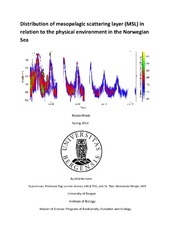Distribution of mesopelagic scattering layer (MSL) in relation to the physical environment in the Norwegian Sea
Abstract
Mesopelagic fish are considered a major group of fishes in the global oceans and are typically observed in the water as acoustic scattering layers. Their biomass has recently been suggested to be severely underestimated, and they might be a major component in the transport of organic material in the water column. I observed the mesopelagic scattering layer (MSL) in the Norwegian Sea and in the Icelandic Sea. I investigated which physical forces might affect diel-vertical migration (DVM) behavior of the MSL. These factors included light, temperature, oxygen and salinity. On the basis of some simplifying assumptions I have approximated the biomass of the MSL and discussed its potential role in the Norwegian Sea ecosystem. My results suggest that the changes in the mean depth (Z_m) of the MSL was consistent with DVM. The variation in Z_m correlated with the variation in surface irradiance. The ambient light of the Z_m showed far less variation than the surface irradiance. These observations suggest that DVM of the MSL emerges from a tendency of the organisms of the MSL to stay within a certain light regime which appears consistent with the antipredation window hypothesis. Other physical factors did not seem to affect the DVM patterns. Benthosema glaciale were present in the trawl catches and might have been an important component of the MSL. The density, and thereby the approximated biomass, of the MSL decreased along the track concurrently with a decrease in temperature. The approximated biomass appeared to be larger than indicated in previous studies based on net sampling. My estimate, however, is subject to large uncertainties which include species composition, target strength and weight values.
